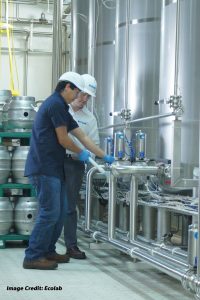 To succeed today, food and beverage producers know they must meet four objectives: 1) produce safe, high-quality products, 2) operate efficiently, 3) increase profitability, and 4) reduce water, energy, and waste.
To succeed today, food and beverage producers know they must meet four objectives: 1) produce safe, high-quality products, 2) operate efficiently, 3) increase profitability, and 4) reduce water, energy, and waste.
They also know that to achieve these objectives, they can’t overlook clean in place (CIP). If CIP is not done well, producers risk contaminated products, production downtime, higher costs, and increased natural resource consumption. Further, poor quality and product recalls can damage brand reputation, lead to litigation and undermine hard-earned customer, consumer, and shareholder trust.
However, the challenge with CIP is evaluating how—and how well—it cleans at each wash. It’s like an old friend who, after years of friendly give and take, still holds tight to his secrets.
The industry has certainly tried to peer beneath the surface to learn what’s really going on during the CIP process. Periodic manual evaluations have provided helpful snapshots of CIP performance, but they could not be used to validate effectiveness across all washes. Increasing the frequency of manual evaluations to truly meaningful levels has simply not been practical.
In addition, when Programmable Logic Controllers (PLC) coupled with field instrumentation, advanced Human Machine Interfaces, and electronic Historian Databases became the standard of control within CIP operations, the industry expected greater insight into CIP performance. These technologies did generate reams of data. But developing platforms that could translate it into actionable insights required special expertise and considerable expense. In the end, the data offered limited practical value for understanding CIP performance.
With no good way to assess each clean, QA and plant operations teams have taken it largely on faith that CIP activities are being performed as intended. When Ecolab, which has partnered with fluid flow processors to enhance this sanitation technology for over 55 years, asks customers what percentage of the time they believe their CIP washes are done correctly, they usually answer “around 100 percent.”
Such assumptions can be risky. For instance, when Ecolab installed an automated CIP monitoring system at several customer locations, only 30 to 50 percent of washes were running optimally. So far, the absolute best rate of conforming washes the company found has been between 60 and 70 percent. Non-conforming washes suggest trouble on one of two fronts: either resources are being wasted (too much water and/or chemical) or food safety is at risk (too little water and/or chemical.) Of the two, the impact on quality has been far and away customers’ top concern. Resource use and associated costs have been a distant second.
Recently, the quest for effective, comprehensive CIP monitoring has taken a promising turn, thanks in large part to the Internet of Things and big data. The marriage of these two thoroughly modern inventions has led to systems capable of monitoring CIP washes 24/7 and providing specific insights into current and emerging CIP performance problems.
These advanced automated monitoring systems collect real-time CIP process data from the customer’s industrial network (PLC and/or Historian Database), encrypt it, and transmit it to data centers where the data is aggregated. Sophisticated algorithms then scour the data for patterns and deviations that indicate compliance or non-compliance with prescribed wash protocols. Importantly, these algorithms are designed to translate the data in a CIP context to help ensure the relevance of the output.
Data analytics experts provide further interpretation of the data to discern problems that need immediate attention—and opportunities for future improvement. Ultimately, the analysis separates the “critical” from the merely “interesting.” With such clarity, recommendations can be developed to address immediate and long-term challenges.
Armed with actionable recommendations, internal and external technical teams can waste no time getting to the most urgent issues. In fact, for greatest impact, all data analysis should lead to action plans that can be incorporated in the plant’s service platform.
From Transparency Comes Impact
Food and beverage producers who have implemented these 24/7 automated CIP monitoring systems report positive impact on quality and operational metrics, as seen in the following examples.
ACCESS THE FULL VERSION OF THIS ARTICLE
To view this article and gain unlimited access to premium content on the FQ&S website, register for your FREE account. Build your profile and create a personalized experience today! Sign up is easy!
GET STARTED
Already have an account? LOGIN

